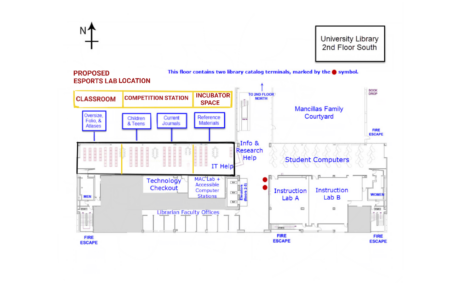Leo F. Cain Library will soon gain an esports lab. Photo by Iracema Navarro.
Clarification: In a story that ran in the Feb. 3 e-edition and posted on our website Feb. 5, it was implied that library Dean Sterling wrote in a Nov. 25 email to library staff that the decision to put an esports lab on the second floor of the library surprised her. What Sterling was referring to was not the esports location, which had been known since last spring, but that the construction on the lab would begin March 2021.
Also, in the version of this story that ran in the Bulletin’s e-edition, five words that began a quote in an email from library Dean Stephanie Grassley were inadvertently cut out. This version has been amended to include those words.
By Taylor Helmes, Editor in chief, Brenda Fernanda Verano, News Editor and Daniel Tom, Contributing Reporter
The building making the biggest noise on campus is the one that is supposed to be the quietest: the university’s library. Specifically, the second floor on the south side behind the research help desk, where campus officials have confirmed that a $750,000 esports lab will begin construction next month.
The lab will include a classroom, a competitive area and incubator space. It is the latest step in expanding the university’s esports profile. An esports certification program was launched last semester, and in 2017 an esports club that plays competitively was created.
Although no official announcement has yet been made about the esports lab, CSUDH President Thomas A. Parham mentioned it in the Academic Senate’s Dec. 2 meeting, as well as in an interview with the Bulletin shortly after.
In both instances, he emphasized that the lab will not be used exclusively for competitive gaming or recreational gaming. It will combine gaming-related research and competitive gaming. It could also help with retaining students in danger of dropping out of school because expanding video games would meet some students, “where they are,” Parham said. Students will also learn skills such as geometry and coding that will translate into more traditional academic realms.
“This should benefit hundreds, and hundreds of students,” Parham said in the Dec. 2 meeting.

However, not everyone feels they are benefiting from an esports lab built in a part of the library currently used as a quiet study area. A day after Parham’s comments at that meeting, the Bulletin received an email signed Concerned Toro.
“If there is a demonstrated need for an ESports Lab on the CSUDH campus, should it be at the expense of study space in the Library which in non-covid times, serves students 7 days a week?” Concerned Toro said, asking that their identity be kept anonymous.
Parham told the Bulletin in mid-December that other spaces were considered for the esports lab, including the existing game room in the Loker Student Union. But the library space fit the criteria best, he said.
“We have to have a space that is centrally located, easily accessible, and has hours during the day and on the weekend that would allow us to navigate the space,” Parham said.
Amy Bentley-Smith, an official spokesperson for the university, shared Parham’s assessment.
“The location also provided greater visibility of the esports program to all students, as well as public access, and the space needed to facilitate the academic instruction, research, tutoring, and co-curricular learning needs, which are expected outcomes of the e-sports program,” she said.
Concerned Toro and one other library source who wished to remain anonymous said library staff expressed their feelings that library were not as involved in the selection process as they should have been. As an example: most of the staff knew the library was being considered as a site,but when the Nov. 24 notification about the library being chosen, they were surprised.
The next day, library Dean Stephanie Sterling wrote in an email to library personnel that the last she’d heard of the project was early summer. The project was still in its planning stages at that point and the Nov. 25 announcement confirming the lab would be in the library was unexpected.
“I was surprised to learn third-hand, yesterday that this project is moving forward in January,” Sterling wrote.
“I think what you’re seeing is frustration for how the library is left out of planning in projects that significantly impact us,” the library employee who asked to be anonymous told the Bulletin. “That certainly happened with the (2019) renovations and impacted our library operations and this feels like a repeat of that,” she added.
In 2019, the third and fourth floors of the North Library were reconfigured to accommodate the Student Success Hub.
Parham’s support for esports traces back to his days as the vice chancellor for student affairs at the University of California, Irvine (UCI), the first public university to create an esports program. During his time at UCI, he was a strong component for the achievement of their 3,500-square-foot esports arena initiative, as stated in UCI news story in 2016.
Marymount California University in Rancho Palos Verdes is another campus where esports culture has boomed, MCU recently completed its inaugural season and already competed with schools like CSUDH and Sacramento State University, in games such as Valorant, Rocket League, and more last fall.
“Like other competitive team sports, eSports is a great way to develop leadership skills, promote teamwork and nurture discipline,” MCU Athletics Director Courtney Thomsen said.
“Participation can improve critical thinking, problem solving and communication—all transferable skills for success in the classroom, too!”
The construction of the esports lab comes in a time of budget shortfalls and employee furloughs on campus, and when the North Library continues to operate without sprinklers.
But Bentley-Smith said no money for the esports lab is coming from funds that could be used for those purposes.
“General fund dollars are not being used in support of the project,” she said, Instead the construction will be done using one-time capital improvement funds, she said.


